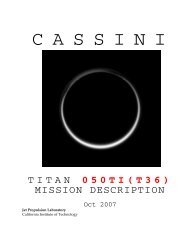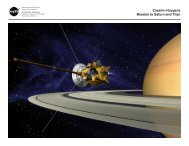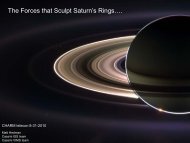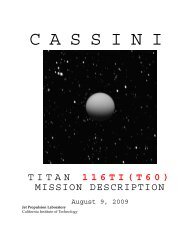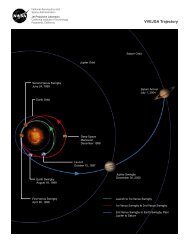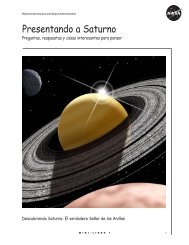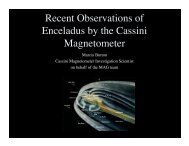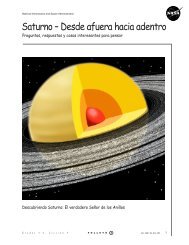Gingerbread Spacecraft - Cassini - NASA
Gingerbread Spacecraft - Cassini - NASA
Gingerbread Spacecraft - Cassini - NASA
Create successful ePaper yourself
Turn your PDF publications into a flip-book with our unique Google optimized e-Paper software.
National Aeronautics and<br />
Space Administration<br />
Educational Product<br />
Educators<br />
& Students<br />
Grades 1–4<br />
EB-2001-12-012-JPL<br />
Educational Brief<br />
C A S S I N I S C I E N C E I N V E S T I G A T I O N<br />
<strong>Gingerbread</strong> <strong>Spacecraft</strong><br />
Objective<br />
To construct a model of the <strong>Cassini</strong> spacecraft using edible<br />
products, much like a gingerbread house.<br />
High-Gain Antenna Dish<br />
Electric Antenna<br />
(1 of 3)<br />
Sun Sensors<br />
(2 Inside Dish;<br />
Not Visible)<br />
Magnetometer Boom<br />
Time Required: 1 to 2 hours<br />
Saturn System Analogy: <strong>Cassini</strong> orbiter and Huygens<br />
probe<br />
Keywords: Antenna, Instrument, <strong>Spacecraft</strong><br />
Electric Antenna<br />
(2 of 3)<br />
Huygens<br />
Probe<br />
MATERIALS<br />
•Ice cream cone with a flat bottom and a<br />
cup-like top<br />
Electric Antenna<br />
(3 of 3)<br />
•Cake mix (made according to box instructions)<br />
•Cake frosting — or “ornamental” frosting<br />
(gingerbread house frosting), which adheres more<br />
effectively than standard cake frosting<br />
•Chocolate wafer candy bar<br />
•Candy mint still in its wrapping (preferably a<br />
metallic wrapping, or wrap it in aluminum foil)<br />
•Small marshmallows<br />
•Piece of licorice<br />
•Small, disk-shaped candies (e.g., M&M’s ® )<br />
Discussion<br />
Major portions of a spacecraft can be easily modeled using<br />
edible components. In this activity, students “construct” an<br />
edible “spacecraft” featuring some of the major components<br />
of the real thing. As illustrated, the <strong>Cassini</strong> spacecraft features<br />
a large dish antenna for communicating with Earth<br />
mounted on the main body of the spacecraft. A long boom<br />
out the side carries a magnetometer, an extremely sophisticated<br />
compass for measuring the direction and strength of a<br />
planetary magnetic field. It represents one of many scientific<br />
instruments aboard. Sun sensors near the main antenna represent<br />
one of the engineering subsystems on the spacecraft.<br />
<strong>Gingerbread</strong> <strong>Spacecraft</strong><br />
EB-2001-12-012-JPL<br />
JPL 400-1027 05/02
Procedure<br />
1. Fill the ice cream cone 2/3 full of cake mix. Bake according<br />
to the cake mix instructions, just as for a cupcake.<br />
2. Place a layer of frosting on top of the “cake.”<br />
3. Fold the licorice in half and poke the ends into the cake.<br />
The licorice should make an inverted V sticking out of<br />
the cake. This represents the support structure on the<br />
interior of <strong>Cassini</strong>’s high-gain antenna dish.<br />
4. Using frosting as glue, place two disk candies around the<br />
inside of the top of the ice cream cone. These represent<br />
the Sun sensors that tell the spacecraft where the Sun is.<br />
5. Cut a hole in the ice cream cone right under the cake<br />
“antenna.” Insert the chocolate wafer into the cone. Using<br />
frosting as glue, place a marshmallow on the end of the<br />
chocolate wafer. This represents the magnetometer boom.<br />
6. Holding the cone with the chocolate wafer pointing to<br />
the right, take the candy mint and attach it to the side<br />
of the cone that is facing you. Use frosting as glue. This<br />
represents the Huygens probe.<br />
Technology Standards<br />
A visit to the URL http://www.mcrel.org yielded the following<br />
standards and included benchmarks that may be applicable to<br />
this activity.<br />
4. Understands the nature of technological design.<br />
LEVEL 1 (GRADES K–2)<br />
Knows that both objects and systems occur in nature (e.g.,<br />
stars and the solar system), but people can also design and<br />
make objects and systems (e.g., telephones and communication<br />
systems) to solve a problem and to improve the quality<br />
of life.<br />
5. Understands the nature and operation of systems.<br />
LEVEL 2 (GRADES 3–5)<br />
Knows that when things are made up of many parts, the<br />
parts usually affect one another.<br />
Understands the relationships between elements (i.e., components,<br />
such as people or parts) in systems.<br />
Extension<br />
Using a diagram of the spacecraft and some imagination,<br />
add additional instruments and engineering components<br />
onto your spacecraft. For a more detailed listing of <strong>Cassini</strong>’s<br />
subsystems, visit http://saturn.jpl.nasa.gov/cassini/english/<br />
spacecraft/ or order a copy of the “Ways of Seeing” CD-ROM<br />
at http://saturn.jpl.nasa.gov/cassini/english/products/. The<br />
“Saturn Educator Guide” (available for download at http://<br />
saturn.jpl.nasa.gov/cassini/english/teachers/activities.shtml)<br />
includes an activity associating <strong>Cassini</strong>’s subsystems with<br />
analogs from everyday life.<br />
Teachers — Please take a moment to evaluate this product at<br />
http://ehb2.gsfc.nasa.gov/edcats/educational_brief.<br />
Your evaluation and suggestions are vital to continually improving<br />
<strong>NASA</strong> educational materials. Thank you.<br />
<strong>Gingerbread</strong> <strong>Spacecraft</strong><br />
2<br />
EB-2001-12-012-JPL



